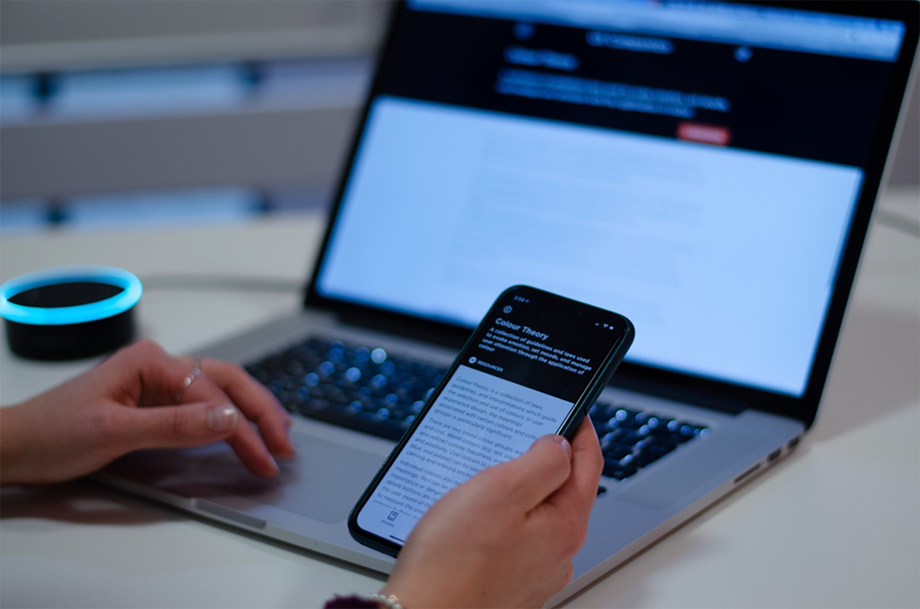So, you’re convinced that you should develop a conversational user interface. What next? As ever, I’d argue that you must follow a user-centred design process to develop your voice assistant or chatbot. Tackling the technology is the next step. I’ll outline the options.
Principles for building a conversational interface
During the production of your conversational interface, you should follow these principles.
- Purpose – allow users to complete specific goals that align with needs of the business in an intuitive way.
- Intelligence – follow a UX process to understand your users’ context and learn through data, errors and conversations.
- Personality – adopt a distinctive personality that encourages users to complete end goals.
Download our Conversational UI Guide to understand the exact user-centred process you should undertake to develop the logic and flow of your conversational interface.
Now, we’ll tackle your first decision – voice skill or chatbot? Learning how they understand the underlying intent in human phrases is critical before reviewing the platforms out there.
Alexa skill developer
As I previously outlined, the main opportunity for businesses with voice assistants is twofold. Firstly, SEO specialists need to optimise your website content for voice search. My article on the future of search outlines how you can do just that.
Secondly, you can develop a ‘skill’ for Amazon Alexa. Of course, it’s possible to bypass this walled garden and build your own platform; but I’d argue that most businesses’ entry points are about using the already-popular technology out there.
Alexa Skills contain an invocation name (often the same as the app name), intents and utterances. The NLP can detect the intent and allow Alexa to say an appropriate piece of information or action.
Our example here is UX Companion, with that as the invocation name. First released in 2015, UX Companion is a handy glossary of UX terms. It’s intended to help UX designers and marketers refresh their knowledge.
An example from our app would be:
- Alexa, open UX Companion
- Alexa, what is a/b testing?
Amazon has a good primer on how to plan, design and develop an Alexa Skill. If you’d like assistance from an Alexa skill developer, please get in touch with us.
Chatbot development
Chatbots differ from voice assistants as they sit on your own website or within Facebook Messenger. As such, there’s a more intensive planning, design and development period to create a chatbot that’s tailored for your own user experience.
If you have complex requirements (e.g. security), it’s best to engage with a user experience agency like us to for custom chatbot development. If you’re after an MVP, there’s a multitude of chatbot development platforms out there that offer strong functionality out-of-the-box. But, don’t forget to start with the user experience (not the tech!). Our Conversational UI Guide can help. Nevertheless, our top list includes:
- Bold360 – we’ve used this to develop Avery, a prototype for our own website. Its cloud-based AI solution can help you manage customer service enquiries.
- Botsify – has an easy drag-and-drop platform, with great added features like Smart AI, machine learning and analytics integrations.
- Beep Boop – as an end-to-end developer experience, it’s great for developing Slack bots as it handles it for you.
- Octaine.ai – this has several pre-built features to take advantage of for your chatbot. All you have to do is insert content!
- Motion AI – this focuses on creating bots via mapping flows for Facebook Messenger, Slack or your own website.
Summary
As a user experience agency, we’d always recommend starting with the user challenge you’d like to solve. It’s useful knowing what technologies are out there, but don’t become wedded to one too early. Research can help you define your requirements and develop the best chatbot development solution for your users. Explore our free UX Handbook for an introduction to the infamous user-centred design process.
This approach guided our development of Jim.Care. Our Founder & CEO, Danny was inspired by helping his elderly neighbour, who often fell and lay for hours unable to call for help. We solved this challenge via a proof-of-concept that combined a few different technologies – Amazon Dash buttons, Amazon Alexa and PIR sensors. Watch the video below to find out more.
If you’d like to build an engaging, user-focused voice skill or chatbot for your own organisation, please get in touch with us.

